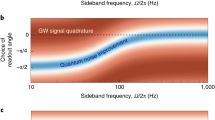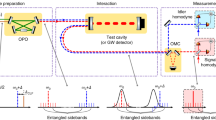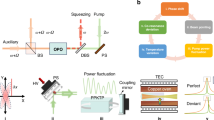
Overview
- Winner of the 2022 GWIC Stefano Braccini Thesis Prize for outstanding PhD research in gravitational waves
- Explores frequency-dependent squeezing in Virgo, a key technique for enhancing gravitational wave detection
- Examines strategies for mitigating stray light in gravitational wave detectors to improve measurement precision
Part of the book series: Springer Theses (Springer Theses)
Access this book
Tax calculation will be finalised at checkout
Other ways to access
About this book
This book presents the first implementation of frequency-dependent squeezing in the Virgo gravitational wave detector, a technique that reduces quantum noise across the entire detection band. By lowering noise, it enhances Virgo’s ability to observe the universe.
It provides a detailed account of the experimental optical system—spanning hundreds of meters—and the measurement campaign that led to the first observation of frequency-dependent squeezing, with ellipse rotation occurring at the target frequency of a few tens of Hz. Additionally, the book covers the characterization and commissioning of a new Output Mode Cleaner cavity in Virgo to minimize optical losses on squeezed states. Finally, it examines the impact of stray light noise at low frequencies and explores mitigation strategies to improve detector sensitivity.
Similar content being viewed by others
Table of contents (11 chapters)
-
Front Matter
-
Gravitational Waves Detection
-
Front Matter
-
-
Broadband Quantum Noise Reduction in Advanced Virgo Plus
-
Front Matter
-
-
Scattered Light Noise in Advanced Virgo Plus
-
Front Matter
-
-
Preparation for Squeezing Injection into the Interferometer
-
Front Matter
-
-
Outlook
-
Front Matter
-
-
Back Matter
Authors and Affiliations
About the author
Eleonora Polini is a physicist specializing in quantum noise reduction for gravitational wave detectors. She earned her Bachelor’s and Master’s degrees in Physics from La Sapienza University of Rome, where she received the Enrico Persico and Tito Maiani Prizes for academic excellence.
She completed her PhD at the Laboratoire d’Annecy de Physique des Particules and Université Savoie Mont Blanc, focusing on frequency-dependent squeezing in the Virgo detector. Her work included upgrading the Output Mode Cleaner cavity and investigating stray light noise, earning her the Virgo Award (2022) and GWIC–Braccini Prize (2023).
She later conducted postdoctoral research at MIT, working on scattered light analysis for LIGO Hanford, assembling Output Mode Cleaner cavities at Caltech, and developing fiber interferometers for entangled-state gravitational measurements.
Currently, she is a Research Scientist at CNRS in the ARTEMIS laboratory at the Observatoire de la Côte d'Azur, focusing on gravitational wave detectors (current and future) and fundamental physics experiments.
Accessibility Information
PDF accessibility summary
This PDF has been created in accordance with the PDF/UA-1 standard to enhance accessibility, including screen reader support, described non-text content (images, graphs), bookmarks for easy navigation, keyboard-friendly links and forms and searchable, selectable text. We recognize the importance of accessibility, and we welcome queries about accessibility for any of our products. If you have a question or an access need, please get in touch with us at accessibilitysupport@springernature.com. Please note that a more accessible version of this eBook is available as ePub.
EPUB accessibility summary
This ebook is designed with accessibility in mind, aiming to meet the ePub Accessibility 1.0 AA and WCAG 2.2 Level AA standards. It features a navigable table of contents, structured headings, and alternative text for images, ensuring smooth, intuitive navigation and comprehension. The text is reflowable and resizable, with sufficient contrast. We recognize the importance of accessibility, and we welcome queries about accessibility for any of our products. If you have a question or an access need, please get in touch with us at accessibilitysupport@springernature.com.
Bibliographic Information
Book Title: Broadband Quantum Noise Reduction in Advanced Virgo Plus
Book Subtitle: From Frequency-Dependent Squeezing Implementation to Detection Losses and Stray Light Mitigation
Authors: Eleonora Polini
Series Title: Springer Theses
DOI: https://doi.org/10.1007/978-3-031-95143-5
Publisher: Springer Cham
eBook Packages: Physics and Astronomy, Physics and Astronomy (R0)
Copyright Information: The Editor(s) (if applicable) and The Author(s), under exclusive license to Springer Nature Switzerland AG 2025
Hardcover ISBN: 978-3-031-95142-8Published: 12 August 2025
Softcover ISBN: 978-3-031-95145-9Due: 26 August 2026
eBook ISBN: 978-3-031-95143-5Published: 11 August 2025
Series ISSN: 2190-5053
Series E-ISSN: 2190-5061
Edition Number: 1
Number of Pages: XXI, 248
Number of Illustrations: 5 b/w illustrations, 145 illustrations in colour
Topics: Classical and Quantum Gravitation, Relativity Theory, Quantum Optics, Astrophysics and Astroparticles, Optics, Lasers, Photonics, Optical Devices
Keywords
- Gravitational wave detection
- Advanced Virgo+ interferometer
- Quantum noise in gravitational wave detectors
- Optical cavities in interferometry
- Suspended optical benches
- Frequency-dependent squeezing in laser interferometers
- Stray and scattered light effects
- Output mode cleaner cavity in interferometers



